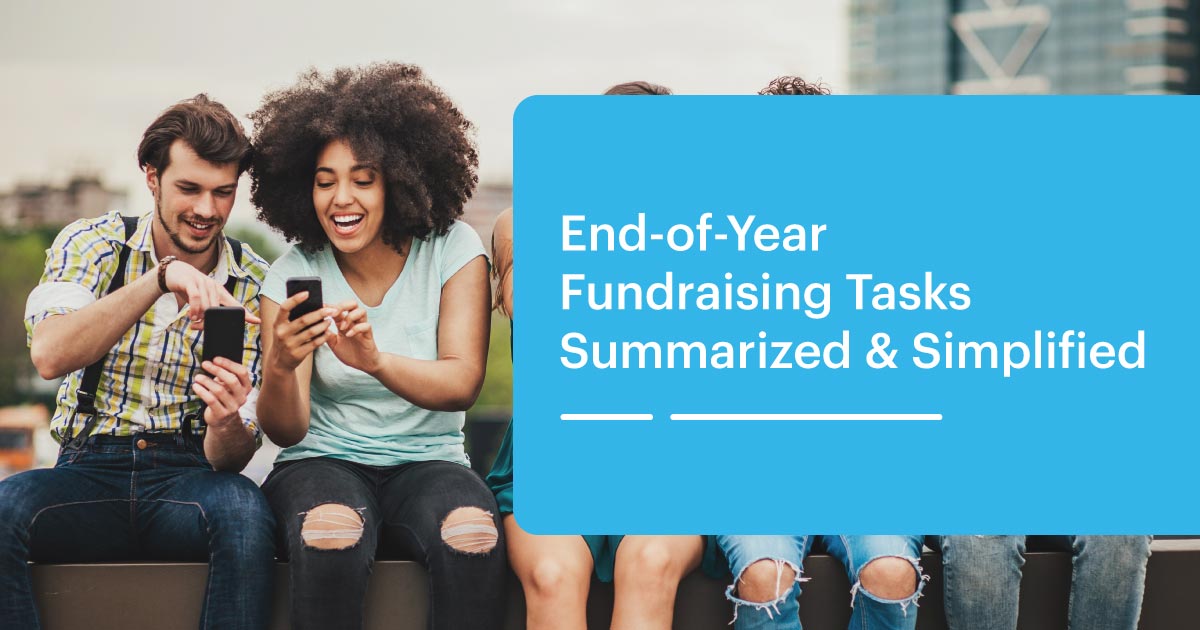Nonprofit Technology & Fundraising Blog
Subscribe to our mailing list
December 27, 2021 |

Nonprofits, have no fear. Your End-of-Year cheat sheet is here. Whether you want to simplify your end-of-year fundraising tasks this year or next, this guide is meant to help you organize now, and mobilize when the New Year comes.
SKIP TO YOUR SPECIFIC NEED:
First, start with a specific goal in mind to determine action steps for your fundraising team, and clear opportunities for your donors to give. Next, make sure everyone on board has a thorough understanding of the plan so that your fundraising strategy stays consistent.
1. What is your end-of-year goal?
It should be measurable, quantifiable, and specific.
Action items:
Understand where funds are needed most. Nail down the dollar amount your nonprofit needs to raise. Determine and approve your campaign budget.
2. Why is this goal important to your mission?
Determine how you and your team will deliver that message.
Action items:
Hold a brainstorming session with your fundraising team, board, and volunteers. Define each member’s role in the campaign and outline what’s needed from them.
3. Which of your past campaigns were successful?
With your data, decide which elements of past campaigns are worth repeating. (Our recent blog has tips to find this information within your data.
Action items:
Using your data, analyze what did and didn’t work last year. Segment contacts based on reports (top donors, previous year-end donors, etc.) Decide which platforms you’ll use to reach each segmented group (social media, phone calls, direct mail, and email).
4. Who can you involve to make your campaign a success?
This could be your top donors, past volunteers and fundraisers, etc.
Action items:
Reach out to donors to thank them for their support this year. Recruit new donors, on and after Giving Tuesday.
5. How will you reach your donors?
Social media, phone calls, direct mail, email, or all of the above. Our (recent blog provides insight into multichannel end-of-year fundraising.)
Action items:
Create a communications timeline, mapping out when and what you’ll send. Assign tasks to the appropriate people. Develop EOY content for letter, email, and social media outreach. Create online donation, crowdfunding, and volunteer forms.
You won’t be able to measure the success of your campaigns and solicitations if your gifts aren’t properly coded. Fortunately, there are easy ways to determine whether they’ve been coded incorrectly – or not coded at all.
1. Codes that make no sense
Take time for a quick reality check – review your codes to spot inefficiencies.
2. A line item for miscellaneous gifts (AKA gifts without codes)
You can find these holes in your database when you spot blanks in reports that break down gifts by solicitation code, general ledger code, and more.
3. Duplicate codes
Let’s say you have two different codes for your 2018 Gala: “18GALA” and “GALA18.” Your results should be listed in alphanumeric order, so it won’t be obvious that the code’s been duplicated.
You won’t get good data out of your CRM if you don’t put clean, complete data in. Now is the perfect opportunity to take control of your database, so you can prevent obstacles to getting tax receipts out and make data-informed decisions for your next year of fundraising.
1. Standardize data entry.
Educate your staff and volunteers on your data entry process, when to create new codes and donors, and how to check for existing codes and donors. Create a document for staff and volunteers to reference when entering data.
2. Only allow trained individuals to enter data.
Having staff and volunteers help with data entry can be a real relief. But sometimes not everyone is on the same page, which can lead to honest, but problematic mistakes that take a lot of time to undo. Ensure that only the right people have access to add or edit codes and other data. Your donor management system should include user settings that you can configure.
3. Schedule a weekly report of any data that’s been added in the last week.
This recurring practice makes it easy for administrators to review newly entered data and correct issues immediately.
Once your final fundraising campaign of the year has been completed, and your database is ready for anything that lies ahead, you will want to report on the success of your end-of-year efforts to simplify the process even further next year.
Follow us on social!